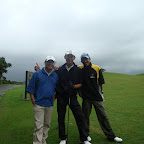I’ve seen so many different approaches to golf instruction that some things have come full circle. For every instructor who says keep your head down, another says let it turn. For every pro who has told his or her students to keep their left arm straight, I’ve heard others (including me) argue that it’s better to allow your arm to naturally bend at the top of your swing. Contradictions are everywhere, especially when it comes to golf instruction.
The question is, who should you listen to? Who’s right, and who isn’t? Well, I’m here to explain some of what I consider to be the most common swing myths, many of which have been wrongfully taught for decades by both golf instructors and amateurs alike.
I’m willing to bet you’ve already heard of a few of these, which is why I’m presenting not only the myth but also the fix. Read on and get ready to eliminate swing myths from your golf game and get your game back on track.
 |
Myth #1: Keep your head down
Who hasn’t heard of this one? Keeping your head down at any point during the golf swing is the last thing you want to do. By keeping your head down (see photo to the left), you stifle your upper body’s ability to rotate. A hindered rotation means my hands will get flippy; my weight will either shift too little, too late or not at all; and furthermore, any chance of solid impact will lessen significantly.
In addition to hurting my ability to hit solid shots, keeping your head down can actually hurt you, physically. It puts a tremendous amount of stress on your neck.
Let your head move
Here’s the right way to do it. See how more of my face is visible under my hat? My head is up, and my neck is in line with the rest of my spine. This enables me to rotate without my head getting in the way. Also, by keeping my head up (and my eyes on the ball, of course), I retain my spine angle better than I do with my head tucked down. Look at the difference in body rotation, arm extension and weight shift. All three factors are directly attributed to keeping my head out of the way.
Myth #2: Keep your left arm straight
A straight, rigid left arm not only can cause you to have a reverse pivot, but also can have the opposite affect on your right arm at impact. In the small photo below, notice what happens if you have too much strain in your left arm at the top—you’ll lose your ability to shift your weight properly, and in doing so, the right arm will straighten too soon on the downswing. So, if the left arm is too rigid, the right arm will do the same through the impact zone.
 |
Let it bend
Hey, if you can keep your left arm straight without strain, go for it. It will add power. But if you can’t, it’s perfectly acceptable to allow for some bend in the elbow. By allowing the elbow to flex, the body will rotate more, and the release through the downswing will be much more fluid. In the photo below, I’ve lessened the tension and strain in my arms, which then allowed my body to rotate much more than it did with a rigid left arm.
Myth #3: Keep your left heel down
 |
 |
 |
 |
|
|
 |
Not everyone is as flexible as Tiger Woods. Scratch that. Nobody is as flexible as he is! If you aren’t flexible enough and you attempt to keep your left heel grounded as you swing, you’re likely priming yourself for a reverse pivot (as shown above). Instead, by allowing your left heel to raise (naturally, don’t force it), the body can shift its weight back and forward much more effectively. Nicklaus, Snead, Palmer, et al. They all lifted their left heel. Why shouldn’t you?
Myth #4: Tuck your right elbow
If you tuck your right elbow too much, here’s what will happen. First, your swing will likely be too flat at the top of your swing. If you stay tucked, your arms won’t be able to swing freely down and through, meaning your body will have to compensate and either cause you to overrotate or come over the top of the ball (as I’m showing here). And in case you didn’t know, coming over the top (from outside the target line to inside the target line) is never a good idea, as it produces all sorts of duffs, hooks and slices.
Let it fly!
Davis Love III has made quite the career by allowing his right elbow to “fly.” In other words, by allowing the right elbow to drift from the body, DL3 can make a huge upper-body turn and keep the clubshaft perfectly on plane. From the top of the swing, he then drops his arms down as he rotates his body through the golf ball.
In this sequence, I’m doing the same thing. By letting my elbow drift up and away from my side as I initiate my downswing, it becomes a lot easier to keep my club perfectly on plane. And check out my impact position in both swings. My body is much more rotated here and in a much more athletic position.
 |
 |
 |
I can’t count how many times I’ve heard other instructors tell their students that the key to successful putting is to keep your head down through the stroke. But before I digress, how many of you can shoot a basket while looking at the ball? Or shoot a target with a gun while staring at the gun?
 Watch it go in! |
In sports, where precise positioning is required, more often than not, the best way to accomplish your goal is to have the mind and eyes fixated on the target. Baseball players need to the see the baseball, primarily because it’s moving at great speeds. They also don’t have to fear hitting it too far, meaning they can swing at full throttle every time and not worry about a lengthy comebacker for par. Putting, like shooting a basketball, requires a deft touch that’s best executed with help from the eyes.
Now, back to my point. By keeping your head down, you stifle the body’s ability to rock the shoulders through the stroke, invariably causing the hands and arms to collapse before, during or even after impact.
A better way to ensure a smooth pendulum stroke is to allow the head to rotate with the putterhead through impact. This will foster a more natural forwardstroke and also help train the eyes to become more accustomed to seeing how far each putt rolls out. The eyes also can help correct any tendencies in your aiming as well, since you can see the effects of the roll.
Practice a few putts and allow your head to rotate (don’t lift your head; rather rotate it from side to side) and get a feel for how far the ball rolls and in what direction with strokes of various lengths. In no time, you’ll see and feel what it’s like to become a better putter.
Bobby Hinds, PGA, teaches at Woodley Lakes GC in Van Nuys, California. For more information, call (323) 363-7761
Source : www.golftipsmag.com




































































































